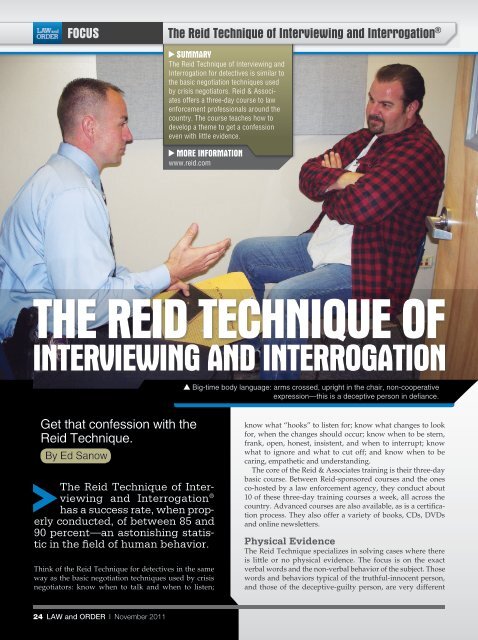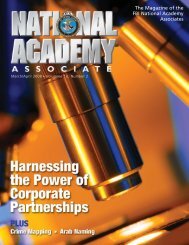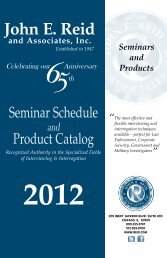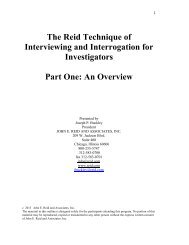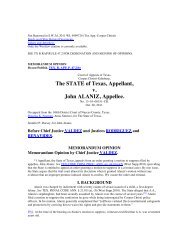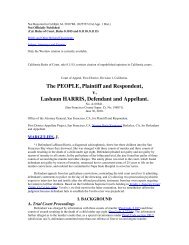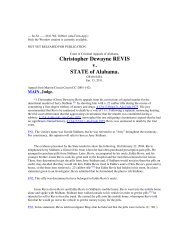THE REID TECHNIQUE OF
INTERVIEWING AND INTERROGATION - The Reid Technique of ...
INTERVIEWING AND INTERROGATION - The Reid Technique of ...
- No tags were found...
You also want an ePaper? Increase the reach of your titles
YUMPU automatically turns print PDFs into web optimized ePapers that Google loves.
FOCUS The Reid Technique of Interviewing and Interrogation ®<br />
SUMMARY<br />
The Reid Technique of Interviewing and<br />
Interrogation for detectives is similar to<br />
the basic negotiation techniques used<br />
by crisis negotiators. Reid & Associates<br />
offers a three-day course to law<br />
enforcement professionals around the<br />
country. The course teaches how to<br />
develop a theme to get a confession<br />
even with little evidence.<br />
MORE INFORMATION<br />
www.reid.com<br />
<strong>THE</strong> <strong>REID</strong> <strong>TECHNIQUE</strong> <strong>OF</strong><br />
INTERVIEWING AND INTERROGATION<br />
Big-time body language: arms crossed, upright in the chair, non-cooperative<br />
expression—this is a deceptive person in defiance.<br />
Get that confession with the<br />
Reid Technique.<br />
By Ed Sanow<br />
The Reid Technique of Interviewing<br />
and Interrogation ®<br />
has a success rate, when properly<br />
conducted, of between 85 and<br />
90 percent—an astonishing statistic<br />
in the field of human behavior.<br />
Think of the Reid Technique for detectives in the same<br />
way as the basic negotiation techniques used by crisis<br />
negotiators: know when to talk and when to listen;<br />
know what “hooks” to listen for; know what changes to look<br />
for, when the changes should occur; know when to be stern,<br />
frank, open, honest, insistent, and when to interrupt; know<br />
what to ignore and what to cut off; and know when to be<br />
caring, empathetic and understanding.<br />
The core of the Reid & Associates training is their three-day<br />
basic course. Between Reid-sponsored courses and the ones<br />
co-hosted by a law enforcement agency, they conduct about<br />
10 of these three-day training courses a week, all across the<br />
country. Advanced courses are also available, as is a certification<br />
process. They also offer a variety of books, CDs, DVDs<br />
and online newsletters.<br />
Physical Evidence<br />
The Reid Technique specializes in solving cases where there<br />
is little or no physical evidence. The focus is on the exact<br />
verbal words and the non-verbal behavior of the subject. Those<br />
words and behaviors typical of the truthful-innocent person,<br />
and those of the deceptive-guilty person, are very different<br />
24 LAW and ORDER I November 2011<br />
Law_Nov_Focus.indd 24<br />
12/14/2011 1:37:20 PM
INVESTIGATIONS<br />
and surprisingly easy to recognize.<br />
Non-verbal behavior is more reliable than spoken words.<br />
Non-verbal behavior is responsible for more than half of the<br />
meaning of the communicated message. Non-verbal behavior<br />
may support, or contradict, the verbal words. The key is how<br />
to evaluate what the detective sees and hears. But most importantly,<br />
the Reid Technique teaches how to develop a theme or<br />
series of themes to spring the trap even with very little supporting<br />
evidence.<br />
In Reid-speak, a theme is a face-saving, rationalized, or good<br />
and acceptable excuse (in the mind of the guilty) for why they<br />
committed the crime. This is a critical part of the Reid Technique.<br />
After a carefully structured preparation, the suspect is<br />
going to be given the choice between a really good reason and<br />
a much worse, less-acceptable reason for having committed the<br />
crime. Accepting either is an admission of guilt. And properly<br />
timed, it works.<br />
Investigative Interview<br />
The Reid Technique picks up where the routine criminal investigation<br />
leaves off. This course does not deal with the basics<br />
investigation. It assumes all of the facts and physical evidence<br />
have been gathered. Instead, the Reid Technique is about interviewing<br />
and then interrogating, which are two separate and<br />
very different phases.<br />
Even the interviewing phase of the Reid Technique picks<br />
up after all the standard clerical, non-threatening, background<br />
questions are asked. This phase begins with all the who, what,<br />
when, where, why and how questions, all of which may have<br />
been asked of the suspect before by another officer.<br />
During this phase, the Reid Technique teaches the detective<br />
to pay attention to comments volunteered, or answers to questions,<br />
that can be later used to develop the theme—that good,<br />
face-saving excuse for why the suspect did the deed. Theft<br />
of money? Listen for problems paying bills—even if you are<br />
pretty sure this is not the reason for the theft. Sexual assault?<br />
Listen for comments about provocative actions or clothes.<br />
This phase moves to one of the Reid Technique trademarks…<br />
behavior-provoking questions. These are a series of 17 primary<br />
questions where the responses (both verbal and non-verbal) of<br />
a truthful person are clearly different from those of a deceitful<br />
person. Of the 17 innocent sounding, thought-provoking<br />
questions, only half of them will need to be asked for the detective<br />
to have confidence about innocence or guilt.<br />
These are the kind of questions designed to elicit some kind<br />
of a response. The detective must carefully watch the suspect<br />
before, during and just after the answer to note that response.<br />
The detective is looking for attitude, body posture, eye contact,<br />
tension-relieving gestures, facial expressions, as well as listening<br />
for the precise verbal content.<br />
With attitude, both truthful and deceptive persons can be<br />
nervous, fearful and angry. The timing of their anger, and if it<br />
is constant, spikes or diminishes, are all factors indicating guilt<br />
or innocence. Facial expressions, of course, reflect the person’s<br />
attitude. Look for sincere expressions as opposed to the phony,<br />
fake, rehearsed ones.<br />
Forward or upright in the chair, head up, eyes looking<br />
at investigator, open arms—he is listening, and the<br />
investigator needs to keep him listening.<br />
With the head down, shoulders slumped, looking at the<br />
floor, yielding, the deceptive person now totally defeated.<br />
www.lawandordermag.com 25<br />
Law_Nov_Focus.indd 25<br />
12/14/2011 1:37:26 PM
FOCUS<br />
The Reid Technique of Interviewing and Interrogation ®<br />
Body Posture<br />
Body posture is pretty easy to read,<br />
but watch for changes in posture in response<br />
to specific questions. Tension,<br />
anxiety and stress-relieving gestures are<br />
important and also pretty easy to read.<br />
The key is to correlate the timing and<br />
the consistency of these gestures with<br />
the exact behavior-provoking questions.<br />
Eye contact is important—the eyes are<br />
windows to the soul—but should be put<br />
in perspective with all the other nonverbal<br />
indicators. Normal eye contact is<br />
maintained between 30 and 60 percent<br />
of the time in normal conversations<br />
between two people. Be careful not to<br />
rely too much on this one aspect.<br />
In the same way, a neurolinguistic<br />
evaluation may be over-rated. (This<br />
is where the subject breaks the gaze<br />
up and left, or down and to the right.)<br />
Instead, during the clerical, non-threatening<br />
part of the interview, concentrate<br />
on establishing the normal baseline of<br />
eye contact this person uses.<br />
The interrogation theme is a good excuse, a face-saving way for the suspect to<br />
admit guilt…but it has to be one the suspect buys into as his own.<br />
Choose a bumper today<br />
Our new Universal, SUV Standard Push Bumper<br />
!"#$%"!&'%$#()#*%%(#+),-#.%%(#%/,!0*%'(#'%%$"#!'#<br />
today’s economy. *Transferable between any Police<br />
12342&%#567"8#(9!"#:,*0%-#32'#9%;0#)'#%/,!0*%'(#<br />
costs down the road.<br />
INVESTIGATIONS<br />
Verbal Responses<br />
As for the spoken answers to behavior-provoking<br />
questions, most people<br />
will tell a direct lie only as a last resort.<br />
Instead, the deceptive person will give<br />
an evasive answer, a vague answer,<br />
a delayed answer, or a non-answer<br />
like a head shake or shoulder shrug.<br />
The guilty, deceptive person will try to<br />
manipulate the detective.<br />
The verbal response may also change<br />
in rate of speech, pitch/tone, and<br />
volume depending on what is being<br />
answered or described. In fact, in some<br />
cases, when the manner of speech does<br />
not change, that should attract the attention<br />
of the detective.<br />
Two of the more revealing Reid Technique<br />
questions are: “What do you think<br />
should happen to a person who did this<br />
crime?” and “Do you think the person<br />
who did this would deserve a second<br />
chance under any circumstance?” Truthful-innocent<br />
people and guilty-deceptive<br />
people give very different answers<br />
to these questions. The Reid Technique<br />
has 15 more primary behavior-provoking<br />
questions such as these, as well as<br />
a dozen secondary behavior-provoking<br />
questions.<br />
Transition Phase<br />
During the investigative interview<br />
phase of the Reid Technique, the<br />
detective is completely non-judgmental,<br />
non-threatening, non-accusatory and<br />
non-confrontational. At no time, should<br />
the detective signal by his own verbal or<br />
non-verbal behavior any kind of suspicion<br />
of guilt or conclusion of innocence.<br />
After a short break “to check on further,<br />
expected information related to this<br />
case,” the detective makes a transition.<br />
The transition is from the interview to<br />
the positive-confrontation interrogation.<br />
With firm and direct language, the<br />
detective tells the suspect the results<br />
of the investigation clearly show the<br />
person is guilty of the crime.<br />
This will be the first time the suspect<br />
gets this message from the formerly<br />
non-confrontational detective, and that<br />
change in the detective’s approach will<br />
be part of the wake-up call. Note the<br />
verbal and non-verbal response.<br />
Then the detective will immediately<br />
transition roles again—this time from<br />
being an accuser to being sympathetic<br />
and understanding. The detective is trying<br />
to figure out why this “otherwise<br />
good person make this one-time mistake<br />
in judgment.” What factors, people or<br />
circumstances simply forced the suspect<br />
to do this?<br />
Interrogation Theme<br />
The most important phase of the Reid<br />
Technique is developing and delivering<br />
the interrogation theme. The theme,<br />
again, is a good reason, excuse or facesaving<br />
way for the guilty person to<br />
admit guilt. The detective develops the<br />
!"#$%$&'(#%&)"&(#<br />
*+&*",-."&(/#<br />
!"#012(#3"45"*("$#%(6<br />
!" #$%&'()"*+),-+,&("<br />
" ./'0"%'12$,<br />
!" 3'04-,5-11$))",'")&*6$<br />
!" 7&&'8)"-11$))",'"<br />
" 0-9-:*+$"/$&$-)$<br />
!" ;*+9$/"
FOCUS<br />
The Reid Technique of Interviewing and Interrogation ®<br />
theme by carefully listening to the suspect<br />
during the interview phase. That<br />
is, the theme must be an excuse or reason<br />
the suspect will buy into and adopt<br />
as his own. It has to be something he<br />
thinks anyhow.<br />
The entire concept of the theme is to<br />
place the blame on someone or something<br />
else, other than the suspect. The<br />
suspect is not likely to outright admit<br />
guilt. However, the theme allows him to<br />
tie his admission of guilt with a really<br />
good, reasonable excuse to save selfrespect.<br />
As a part of this, the detective<br />
can downplay what the suspect did—<br />
contrast it to something much worse<br />
that he did not do.<br />
The theme, the excuse, can be almost<br />
anything. However, it needs to relate to<br />
the crime, and it has to be something the<br />
suspect can adopt as his own. It must hit<br />
close to home or the suspect will reject or<br />
ignore it. That is why the detective must<br />
listen so carefully during the interview<br />
for what would make good themes for<br />
this particular suspect.<br />
The Reid Technique workbook has<br />
dozens and dozens of such themes,<br />
divided by the crime. A list of good<br />
excuses for shoplifting is obviously<br />
different from a list of good excuses<br />
for child molesting. If the theme (excuse)<br />
is good enough, anyone would know<br />
the person had no choice but to do the<br />
crime. That is the kind of theme the<br />
detective wants to find.<br />
Blame Someone Else<br />
While really good excuses for committing<br />
the crime are almost endless, they<br />
all involve putting the blame somewhere<br />
else. It was the way she dressed.<br />
He was flaunting his money. It was the<br />
alcohol. If someone else had just been<br />
doing their job. It was someone else’s<br />
idea. It was just circumstances—an opportunity<br />
came up and you gave into<br />
temptation like anyone would do.<br />
Because this is the cornerstone of the<br />
Reid Technique, a great deal of time is<br />
spent on learning how to listen for clues<br />
for what would be a couple of credible<br />
themes with this particular suspect.<br />
During the interrogation, if one theme<br />
doesn’t resonate with the suspect, the<br />
detective needs to keep presenting other<br />
themes until he gets interest from the<br />
suspect. The detective will begin the interrogation<br />
with the most likely theme.<br />
Denials & Objections<br />
The themes are delivered in a non-stop<br />
monologue. Of course, the suspect may<br />
try to interrupt—any interruption will<br />
be a denial. Do not let the suspect interrupt.<br />
Cut off their denials and return<br />
to the theme. Tell them they had their<br />
chance to explain during the interview.<br />
Heavy denials, or the opposite extreme,<br />
total withdrawal, are probably signs the<br />
theme the detective has selected is just<br />
not registering. Drop that one and go on<br />
to the next one.<br />
Guilty people use a standard set of deceptive<br />
denials. In a few instances, the<br />
detective will make an error in judgment<br />
and move truly innocent people from<br />
the interview phase to the interrogation<br />
phase. Innocent people will use a different<br />
set of truthful denials. The detective<br />
has to recognize the differences, which<br />
are sometimes subtle. The guilty person<br />
will eventually learn the denials are not<br />
working and move on to objections.<br />
Objections are different from denials.<br />
Cut off denials but listen to objections.<br />
What they say in the objection will<br />
help the detective to refine the theme,<br />
or develop a new theme. In fact, objections<br />
may more clearly point to a theme<br />
that will work better than the one the<br />
detective developed based on the nonconfrontational<br />
interview. Don’t try to<br />
refute the objection. Instead, draw it out<br />
and use it against him.<br />
The guilty person will eventually figure<br />
out the detective is not listening to<br />
the denials and is turning the objections<br />
against him. They might just withdraw<br />
and mentally tune-out the detective.<br />
At this point, they will start to focus on<br />
the consequences of telling the truth.<br />
The detective must get the suspect to<br />
focus back on the theme.<br />
The Reid Technique has several ways<br />
to do this. Some are as simple as leaning<br />
in closer to the suspect and attempting<br />
to establish eye contact.<br />
Click on EInfo at - www.lawandordermag.com reader service #19<br />
28 LAW and ORDER I November 2011<br />
Law_Nov_Focus.indd 28<br />
12/14/2011 1:37:30 PM
INVESTIGATIONS<br />
The Alternative Question<br />
When the suspect decides to tell the<br />
truth—linked with a really good<br />
excuse—he will go into a passive,<br />
defeated mode. This will be obvious by<br />
a number of non-verbal behaviors.<br />
However, they may still need incentive<br />
to tell the truth. That incentive is the<br />
alternative question.<br />
The alternative question is the second<br />
most important step in the Reid Technique.<br />
Timing of this question is critical.<br />
Accepting either one of the two choices<br />
in these questions is an admission of<br />
guilt. If asked too soon, the suspect will<br />
realize this and consider it a trick. Later<br />
in the process, the same exact question<br />
will elicit an admission of guilt.<br />
The alternative question is simply<br />
a choice between a good excuse<br />
for the crime and a bad excuse for the<br />
crime. Either choice is incriminating.<br />
Once the suspect goes into a receptive,<br />
defeated mode, the detective will offer the<br />
suspect an alternative question based on<br />
the theme that has worked.<br />
With a verbal admission, the hard part is over; however, the Reid Technique<br />
moves on to getting incriminating details and obtaining the written statement.<br />
At the same time, the detective will<br />
contrast what the suspect did with<br />
something much worse. This serves to<br />
downplay the seriousness of the crimes<br />
and feared consequences. “They could<br />
afford to be robbed, but at least you<br />
didn’t hurt them during the robbery.”<br />
The good excuse, the good theme, the<br />
good choice is based on human weaknesses<br />
and temptations that everyone<br />
has. The good choice involves someone<br />
else’s fault, someone else’s provocation,<br />
or something that would force literally<br />
anyone into doing the crime. The bad<br />
choice is based on what is generally considered<br />
repulsive, degenerate, perverted<br />
or totally unacceptable behavior.<br />
The alternative question can take<br />
many forms, but five main ones are<br />
frequently used. First, are you sorry<br />
for what you did, or do you simply not<br />
care? Second, was this the first time,<br />
or was it just one of many? Third, was<br />
this a spur of the moment thing, a loss<br />
of control, or was this something you<br />
carefully planned out? Fourth, have<br />
you learned from all this and are never<br />
going to do it again, or something you<br />
think you will keep doing? Fifth, were<br />
you talked into this, was it peer pressure,<br />
were you threatened, or was this<br />
all your own idea?<br />
Keep asking the alternative question,<br />
or series of alternative questions. Then<br />
ask them in a leading manner. “This<br />
was the only time, wasn’t it?” “You are<br />
sorry, aren’t you?” When the detective<br />
gets the admission, reinforce it. “Good,<br />
that is what I thought. I knew you were<br />
basically a good person.”<br />
Details of the Offense<br />
An initial verbal admission in response<br />
to answering leading questions is a long<br />
way from a full confession with details of<br />
the crime. However, the hard part is over.<br />
With the same empathy the detective<br />
has shown almost the entire time, elicit<br />
a narrative of the crime, tie the suspect<br />
to the crime with incriminating details,<br />
and move on to the written statement.<br />
The Reid Technique includes a number<br />
of methods to smooth the transition and<br />
limit the chances for a retraction.<br />
During the three-day course, each<br />
aspect of the behavior symptom analysis<br />
and each of the nine steps of interrogation<br />
are reinforced by video of actual interviews.<br />
Expect to see 15 to 20 interview<br />
or interrogation segments on crimes<br />
ranging from murder by stabbing, theft<br />
of evidence, child molesting, shots<br />
fired into passing vehicle, false claim of<br />
abduction, forged checks, drug dealing<br />
and armed robbery at an ATM.<br />
The overall assessment? Every detective<br />
should attend the course. And not<br />
just new detectives. It will help every detective<br />
who has had the guilty suspect<br />
sitting right in front of them, but just<br />
couldn’t get the confession. The threeday<br />
course is also excellent for all patrol<br />
officers and sheriff’s deputies in smaller<br />
towns and cities without detective units<br />
– where the same patrol officer takes the<br />
initial call, performs the investigation,<br />
and conducts the interview. The Reid<br />
Technique deserves its legendary status<br />
in law enforcement.<br />
Photos courtesy of Steve Tracy.<br />
LaO<br />
Post your comments on this story by visiting<br />
www.lawandordermag.com<br />
www.lawandordermag.com 29<br />
Law_Nov_Focus.indd 29<br />
12/14/2011 1:37:33 PM


